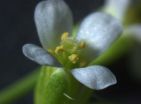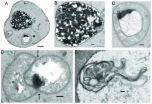(Press-News.org) VIDEO:
A research group at Linköping University has built five different molecular models of the voltage sensor in an ion channel, which together can explain all the experimental data. The five...
Click here for more information.
Every thought, every movement, every heartbeat is controlled by lightning-quick electrical impulses in the brain, the muscles, and the heart. But too much electrical excitability in the membranes of the cells can cause things like epilepsy and cardiac arrhythmia. A research group at Linköping University has now published new discoveries that can lead to new medicines for these diseases.
The key molecules behind the electrical impulses are voltage-activated ion channels – pores in cell membranes, the opening and closing of which are controlled by the electrical potential between the inside and outside of the cell.
Research over the past few years has revealed the ion channels' molecular structure, and how the pores change form when they open and close. On the other hand, the mechanism explaining how the electric potential is detected on the molecular level remains unclear.
LiU researchers have now shown how an ion channel's voltage sensor can change its form. This change of form leads to the pore in the channel opening up.
Ulrike Henrion, Jakob Renhorn, Sara Börjesson, and Erin Nelson, all in Professor Fredrik Elinder's research group, have succeeded through comprehensive experimental work in identifying 20 different molecular interactions that occur in the voltage sensor's different states.
In collaboration with Professor Erik Lindahl's group at the KTH Royal Institute of Technology, and associate professor Björn Wallner at the Department of Physics, Chemistry and Biology at LiU, the group has built five different molecular models of the voltage sensor, which together can explain all the experimental data. The five models were then linked together to a film that shows how a central part of the voltage detector moves between the outer walls of the voltage sensor.
The published work is an important piece of the puzzle in the research group's quest to develop substances with raised electrical excitability, which hopefully can lead to new medicines for epilepsy and cardiac arrhythmia.
###Article: Tracking a complete voltage-sensor cycle with metal-ion bridges by U. Henrion, J. Renhorn, S. I. Börjesson, E. M. Nelson, C. S. Schwaiger, P. Bjelkmar, B. Wallner, E. Lindahl and F. Elinder. Proceedings of the National Academy of Sciences (PNAS) early edition 23-27 April 2012.
Molecule movements that make us think
2012-04-25
ELSE PRESS RELEASES FROM THIS DATE:
PNAS: Precise molecular surgery in the plant genome
2012-04-25
This press release is available in German.
The new method is based on the natural repair mechanism of plants. So-called homologous recombination repairs the genome when the genome strands in the cell break. "Using an appropriate enzyme, i.e. molecular scissors, we first make a cut at the right point in the genome and then supply the necessary patch to repair this cut," says Friedrich Fauser from Karlsruhe Institute of Technology, who is the first author of the PNAS publication. "A part of this patch is the new gene piece we want to install. The rest is done by the ...
The search for a job begins and ends with you
2012-04-25
Staying motivated is always tough, but it certainly gets easier when you start seeing results. That's why keeping your spirits up during a job search can be extremely difficult. Candidates often face repeated rejection and rarely receive any feedback. A new study that focuses on finding work following a job layoff reveals just how important managing negative thoughts and effort over time are while looking for employment.
The research shows that having a more positive, motivational outlook had a beneficial effect on job pursuit, especially at the outset of the search. ...
Family history of liver cancer increases risk of developing the disease
2012-04-25
A family history of liver cancer is reported to increase risk of developing hepatocellular carcinomas (HCC), independent of hepatitis according to findings published in the May issue of Hepatology, a journal of the American Association for the Study of Liver Diseases. The study also shows 70-fold elevated risk of HCC in those with liver cancer in the family and markers for hepatitis B (HBV) or hepatitis C (HCV).
Liver cancer ranks sixth in incidence and the third cause of mortality worldwide. According to the World Health Organization (WHO) liver cancer was responsible ...
Fibrosis and fatty liver disease increase risk of early atherosclerosis
2012-04-25
Italian researchers report that severe fibrosis increases the early atherosclerosis risk in patients with genotype 1 chronic hepatitis C virus (HCV) infection. A second study found that fatty liver disease also increases risk of developing atherosclerosis at an earlier period. Both studies appear in the May issue of Hepatology, a journal published by Wiley-Blackwell on behalf of the American Association for the Study of Liver Diseases.
In the first study, researchers led by Dr. Salvatore Petta from the Di.Bi.M.I.S. University of Palermo in Italy evaluated 174 patients ...
Bile – not acid – is bad guy in triggering precancerous condition associated with reflux disease
2012-04-25
For many people with gastroesophageal reflux disease or GERD, acid reflux drugs are the answer to their woes, curbing the chronic heartburn and regurgitation of food or sour liquid characteristic of the disorder. But when it comes to Barrett's esophagus, a condition commonly found in people with GERD, acid control may be less important than beating back another bodily fluid – bile.
A new study published in the Annals of Surgery shows that bile – a digestive fluid that leaks backwards from the stomach into the esophagus along with acid in patients with GERD – plays a ...
Improving on the amazing: Ames Laboratory scientists seek new conductors for metamaterials
2012-04-25
AMES, Iowa -- Scientists at the U.S. Department of Energy's Ames Laboratory have designed a method to evaluate different conductors for use in metamaterial structures, which are engineered to exhibit properties not possible in natural materials. The work was reported this month in Nature Photonics.
Cloaking devices that hide planes from RADAR, microscopes that can see inside a single cell, and miniature antennae that measure only a few millimeters all sound like parts of a science fiction movie. But, within the span of the decade since they began their work, Ames Laboratory ...
Binge eating may lead to addiction-like behaviors
2012-04-25
HERSHEY, Pa. -- A history of binge eating -- consuming large amounts of food in a short period of time -- may make an individual more likely to show other addiction-like behaviors, including substance abuse, according to Penn State College of Medicine researchers. In the short term, this finding may shed light on the factors that promote substance abuse, addiction, and relapse. In the long term, may help clinicians treat individuals suffering from this devastating disease.
"Drug addiction persists as a major problem in the United States," said Patricia Sue Grigson, Ph.D., ...
Yeast cell reaction to Zoloft suggests alternative cause, drug target for depression
2012-04-25
Princeton University researchers have observed a self-degradation response to the antidepressant Zoloft in yeast cells that could help provide new answers to lingering questions among scientists about how antidepressants work, as well as support the idea that depression is not solely linked to the neurotransmitter serotonin.
In findings published in the journal PLoS ONE, researchers based in the lab of Ethan Perlstein, an associate research scholar in Princeton's Lewis-Sigler Institute for Integrative Genomics and senior lecturer in molecular biology, report that sertraline ...
Pod corn develops leaves in the inflorescences
2012-04-25
This press release is available in German.
In a variant of maize known as pod corn, or tunicate maize, the maize kernels on the cob are not 'naked' but covered by long membranous husks known as glumes. According to scientists from the Max Planck Institute for Plant Breeding Research in Cologne and Friedrich Schiller University in Jena, this variant arises from the activity of a leaf gene in the maize cob that is not usually active there. Thus, pod corn is not a wild ancestor of maize, but a mutant that forms leaves in the wrong place.
Pod corn has a spectacular ...
Rhode Island Hospital researcher: Broadening bipolar disorder criteria is a bad idea
2012-04-25
PROVIDENCE, R.I. – A Rhode Island Hospital psychiatrist and researcher explains the negative impact of broadening the diagnostic criteria for bipolar disorder in the upcoming Diagnostic and Statistical Manual of Mental Disorders, Fifth Edition (DSM-5). In a newly published commentary in the Journal of Clinical Psychiatry, Mark Zimmerman, M.D., explains that lowering the diagnostic threshold for bipolar disorder will likely do more harm than good for patients.
As the debate continues over the revisions to DSM-IV, Zimmerman, the director of outpatient psychiatry at Rhode ...



